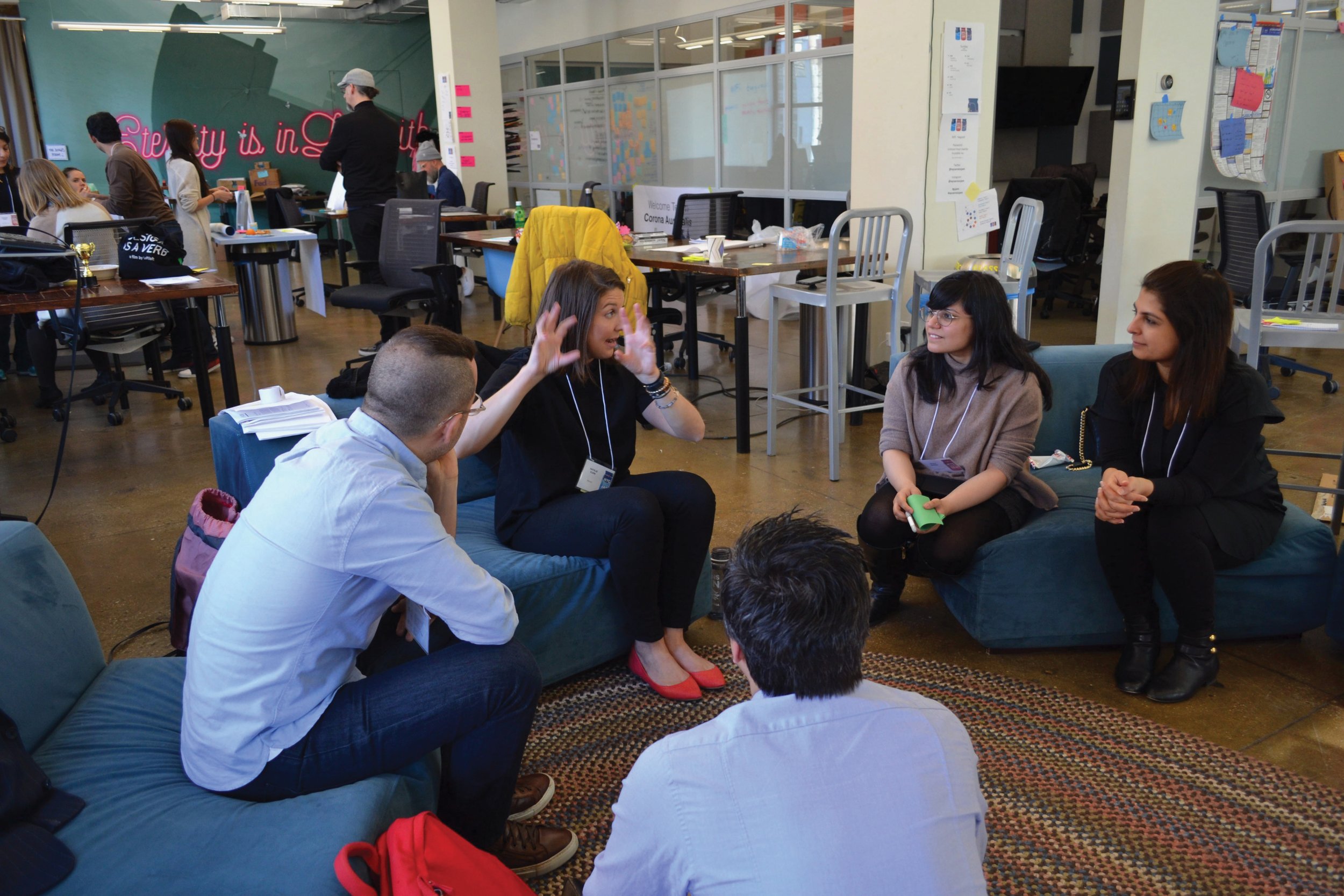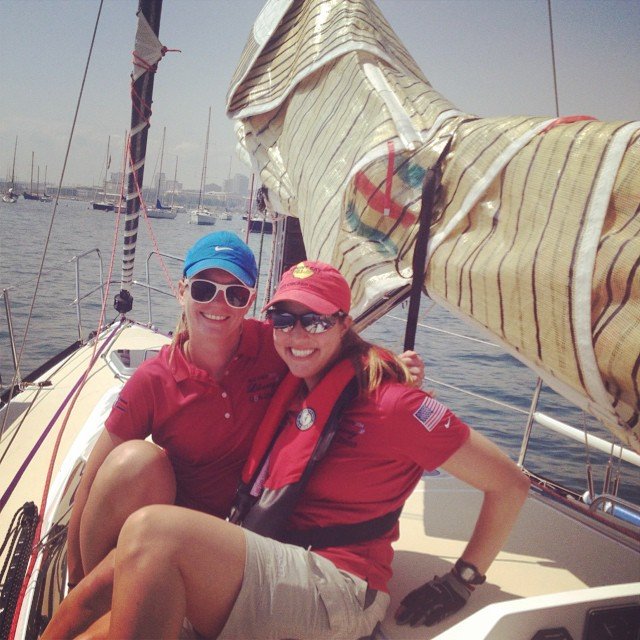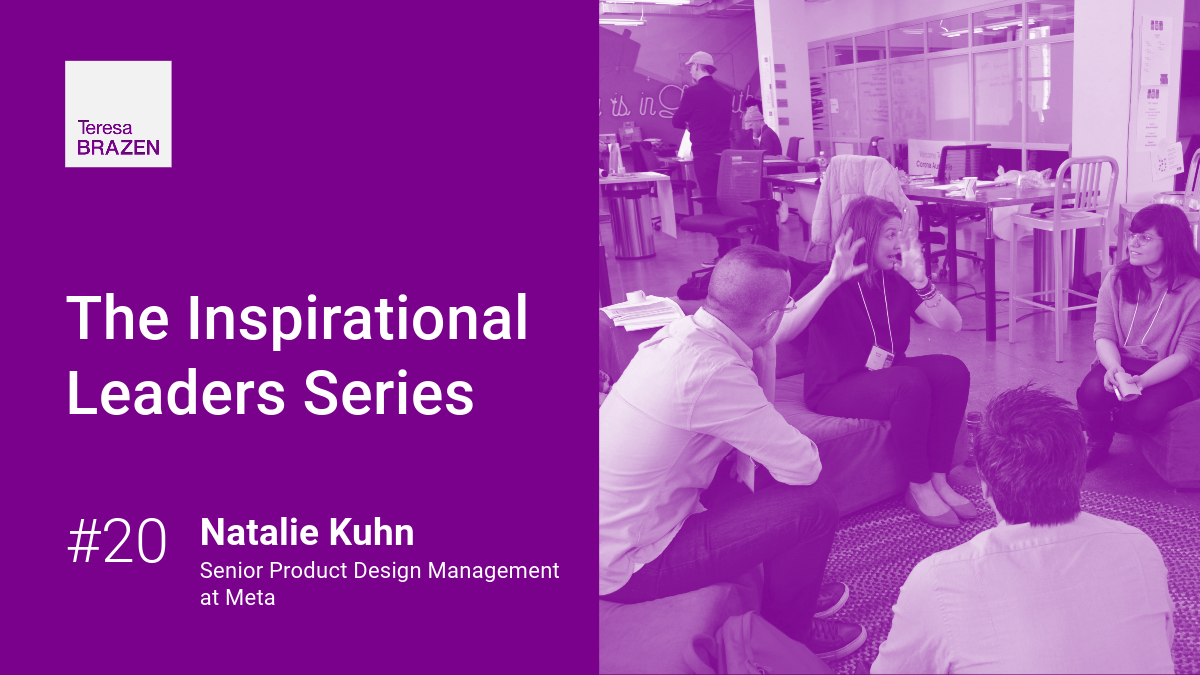“I know there’s a lot of imposter syndrome, not trusting your gut…I would break ‘confidence’ down into really knowing your craft well and believing in the impact and value of that. And that goes hand in hand with believing in yourself…That’s something that I also try to empower within my teams.” - Natalie Kuhn
Welcome to the Inspirational Leaders series, a collection of short interviews with sharp, impactful leaders, because the business world needs more refreshing people like them.
Meet Natalie Kuhn, Senior Design Manager within Data Management and Explainability for Meta. Her team helps people better understand Meta’s data practices as well as what control they have and ways they can manage their data.
(Note: This interview has been lightly edited for length and clarity.)
You have experience at startups, agencies, an in-house design studio, and you also co-founded the New York chapter of the Service Design Network (a nonprofit run by volunteers that aims to make service design more accessible as a discipline and a methodology). I know you’re someone really attuned to an ecosystem-level, holistic perspective. How does that apply to your leadership style?
I love that question. When you're passionate about a way of looking at the world, it seems to just organically appear in everything you do. When it comes to leadership, I think about it in a service blueprint sense: the different stakeholders or swim lanes, the business, the team scope, their influence of impact, and the individual — and how all of those things are connected.
I look at what they're trying to achieve (we could say “jobs to be done”), looking at each of those journeys and how they're all connected. I take on different modes for the individual, the business, [and] the team as needed. Things like being an empathetic listener, being a dot connector, trying to help the business, people, and team see all the different connections we can be making. I think about being an advocate for the goals of the business, the goals of the team, the individuals within the team, and the other designers.
How can we make not only the business successful, but the team, and then ultimately the service we're providing to customers? I'm always thinking about different swim lanes and then — depending on the point of the journey, what we need, the pain point, or the opportunity — it's these modes.
It makes me visualize a loom with a tapestry being woven, and the people are all the different threads. How does that land with you?
It lands pretty well. Maybe it's multiple looms layering together on top of one another, because they're active on different planes, and there are different connection points that can be made.
I would also add, within the modes, I'm teaching, mentoring, and cheering people on (that's a big one that can be overlooked: the value of saying thank you). And then, I’m always evangelizing design and showing versus telling the impact we can have.
Something that strikes me in what you’re describing is complexity. There's a lot of complexity to what you're trying to orchestrate, right?
That comes in a few different layers; always thinking about that ecosystem. The complexity in the roles I've had most recently is around the technology. When we're talking about machine learning, AI, and data privacy, these are really complicated, nitty-gritty topics.
And how to be an impactful leader and really empower those individuals, the team, the business — there's complexity there.
There's almost this soft set of complexity but also this really tactical, tangible complexity around the environment a lot of recent roles are putting me in.
What do you do to simplify it?
I don't know if you can ever remove the complexity. You can focus on different elements of the complexity to help it all make sense together. I think of this ball of thread: you can't take it out, but you can focus on different parts of it. You can make sense of it versus removing any complexity.
What has been a learning moment for you that has shaped how you think about leadership now?
Through the pandemic, through this recession, or whatever time we're in right now, we have not been short of exciting and unprecedented times over the last few years.
Overall, my approach has been to show ego-free leadership, to be vulnerable, but to also balance that with confidence in the future and passion for the next steps with the individual's growth path, the team, and the business. That's definitely a line that is hard to walk.
Be honest about how you're feeling about the situation and help people feel seen in these times of uncertainty — not only in different industries at large but also in these new and emerging places within design.
Believing in the mission of what you're trying to do is so important. [At] the organization I work for, to be direct, it's been very public that there have been layoffs. Coming out of this most recent round, helping the team quickly roll into the next steps, this next evolution. My learning has been action-oriented, trying to find activities or in roadmapping, we're looking toward the future. It is a very natural progression.
It would be easy to just stop moving and sit in reflection of how challenging the last several months [have been]. Helping the team move forward as best we can has been one of my biggest learnings. This nature toward action has been really something that I embrace as a leader.
Leadership during a crisis has a very different style than when you're not in crisis. In the realm of crisis, being action-oriented seems super important.
Yeah, and helping the team find their unique action, helping them see where they fit in and their impact and value right away.
I imagine this tumble into getting up to walk again. What am I contributing? What is my path? What is my impact on this team? What is my impact on the business? What is my impact ultimately on the world in this really unprecedented time? Rolling into action, discovery, and understanding, and really intentional movement toward the future.
You mentioned earlier staying focused on the mission. It sounds like you're talking about action, but also a positive future as a thing we're moving toward together. And you mentioned people understanding their piece of that mission. There's so much complexity to teams of people working in a complicated space with organizational changes. Is this vision of the future the organizing principle, or the thing that, in a way, simplifies all the chaos?
That outcome we're looking for [is] that compass to help cut through the noise and help us ruthlessly prioritize the activities that we take on as a design team, but also as a cross-disciplinary team amongst product, engineering, data science, legal comms, and so on.
Making sure we're all aligned on the vision of where we want to go and then using that as a compass; we're not removing the complexity, but we're carving a path within it, or we're highlighting those different flags that we're following to get to the top of the mountain.
That's a great analogy. There's a reality a lot of design teams face — because in many organizations design is pretty new to the conversation compared to other parts of the business — where design teams aren't always seen as strategic partners or they're underutilized. What have you learned about building teams in that kind of space?
I lean heavily into confidence in the discipline, and confidence in the future. Design works, the methods work, and they've been proven and tested in a variety of different environments. There are plenty of case studies of how design has made strategic contributions to really change the way of a business [even] change the way of society. (I'm not going to be naive and say there haven't been unintended consequences and plenty of opportunities for us to re-investigate the methodology as it relates to design. I want to put that as an aside for now.) Ultimately, design is a crucial partner in making quick decisions and smart decisions, aligning big groups, testing, and learning. I'm including research within capital D design here as well.
As a leader, giving them the space to do what they do, advocating for their activities, and getting them to work quickly to show a positive impact. And then building upon that and getting partners. When I say partners, I'm talking about non-designers [and] other disciplines we work with really closely. Helping them see the impact and the value right away in small steps to open the door a crack and then open it even further to working more collaboratively together on a bigger strategy.
What I hear from you is confidence. So there's being confident in the impact that design can have and being able to show that in a concrete way. But then the other thing I like that you're mentioning is how to set the conditions for designers to show the impact as fast as possible in small bites, the lowest-hanging fruit, and then build on that over time.
Exactly. And I want to add a little bit of detail around the confidence: believing in the method of design, believing in yourself. I know there’s a lot of imposter syndrome, not trusting your gut. I would break “confidence” down into really knowing your craft well and believing in the impact and value of that. And that goes hand in hand with believing in yourself. That’s something that I also try to empower within my teams.
More often than not people know exactly what needs to be done, but they might have something holding them back. I try to empower belief in the craft, and that funnels up into confidence and continued momentum forward.
There have been studies showing that when teams are inspired (by a mission, the environment, etc.), they have more autonomy, they're more creative, and they take more ownership of their work. And, interestingly, they report feeling more confident and having higher self-esteem, which also impacts competition. There's less competition because people feel more confident in themselves. There’s a tie to a lot of the pieces you’ve been talking about.
It's all connected. It's all part of an ecosystem.





